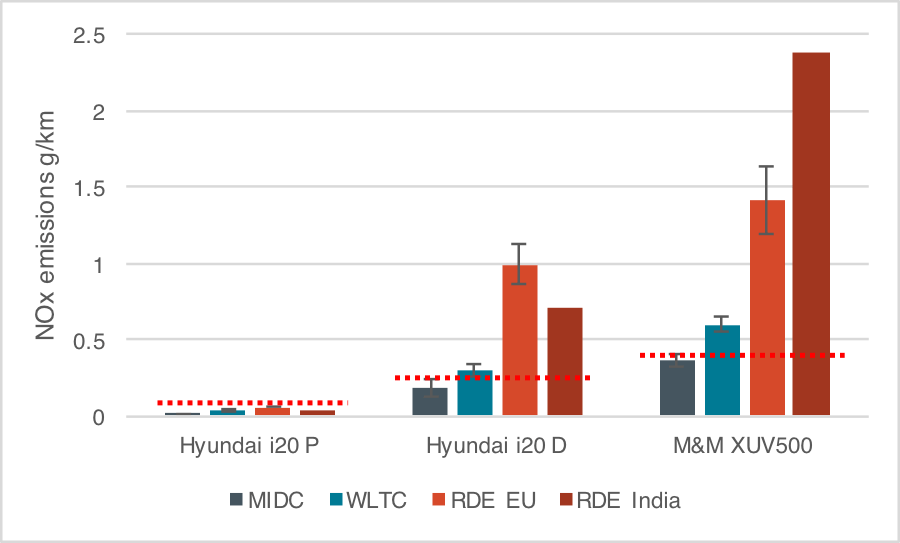Consultant report
Laboratory and on-road emission testing of in-use passenger vehicles in India
Considering the overwhelming evidence of high in-use NOx emissions from diesel cars in Europe and the US, the impact of NOx emissions in human health, and the growing numbers of new diesel passenger cars sold in India, the ICCT decided to investigate the real world emission performance of passenger vehicles in Indian roads.
The ICCT contracted with the International Centre for Automotive Technology (ICAT) of India to conduct laboratory and on-road testing of three in-use passenger vehicles, two diesel and one gasoline. For laboratory testing, emissions were measured under the Modified Indian drive cycle (MIDC), similar to NEDC, and the World Harmonized Light Duty test cycle (WLTC); cold and hot start tests were performed for each vehicle and drive cycle. On-road testing was performed using a portable emissions measurement system (PEMS) under two different trip design conditions: one following the driving conditions as defined under the European Real Driving Emissions (RDE) protocol and another following proper Indian driving conditions. On-road tests were conducted 50 km south west of New Delhi.
The test vehicles were a Hyundai Elite I20 Petrol, a Hyundai Elite I20 Diesel and a Mahindra & Mahindra XUV 500 W6, all MY2015 and certified to Bharat IV, with less than 17,000 thousand km in the odometer. NOx aftertreament included three-way catalyst (TWC) for the petrol car, and exhaust gas recirculation (EGR) for both diesel cars.
The results of the laboratory chassis testing, under MIDC, show that emissions rates for the three vehicles are below type-approval values for all regulated pollutants. WLTC emissions were higher than MIDC emissions for all vehicles; on gasoline vehicles, WLTC emission rates for all pollutants remained below standard values, but both diesel vehicles presented NOx and PM emission rates beyond BSIV standard values. Hot start MIDC emissions were lower for the petrol vehicles as the catalyst reaches light-off temperature faster than under cold start; for the diesel vehicles, hot start MIDC NOx emissions were consistently higher than the cold start, for both MIDC and WLTC tests.
Real driving emissions during PEMS testing show a substantial increase compared to MIDC emission standard values. NOx emissions for diesel vehicles increased between 4 to 6 times when compared to the corresponding standard (Figure 1). For the petrol car, CO emissions increased by almost 4 times under RDE conditions. Fuel Economy was 20 to 25% lower under RDE for all 3 vehicles when compared to type approval values.
The difference in emissions performance between the diesel and gasoline cars were striking. Real driving NOx emissions from i20-diesel were 18-20 times more than i20-petrol; real driving NOx emissions from XUV500 diesel were 25 to 66 times more than i20-petrol.
Note: Red dotted lines represent the corresponding Bharat Stage IV (BS IV) NOx emission standard according to vehicle type: 0.08 gNOx/km for gasoline; and 0.25 gNOx/km for a diesel vehicle with gross vehicle with GVWR<2500 kg, and 0.39 gNOx/km for a 7-seater diesel passenger vehicle.
Staff contact: Anup Bandivadekar

